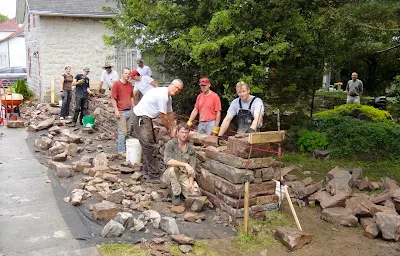
 This is a course well worth signing up for and booking your flight now. Author, heritage restoration mason, lime mortar expert, and dry stone walling instructor Patrick McAfee will be teaching this 2nd annual Irish workshop event on Inisheer Island this September. The cost is only 75 Euro for the 3 days. There will be a practical Aran Island wall building class run by Patrick over the 3 day plus a number of speakers at night, a roast pig on a spit event (hopefully), music and much more. To sign up write to mmannion@galaycoco.ie
This is a course well worth signing up for and booking your flight now. Author, heritage restoration mason, lime mortar expert, and dry stone walling instructor Patrick McAfee will be teaching this 2nd annual Irish workshop event on Inisheer Island this September. The cost is only 75 Euro for the 3 days. There will be a practical Aran Island wall building class run by Patrick over the 3 day plus a number of speakers at night, a roast pig on a spit event (hopefully), music and much more. To sign up write to mmannion@galaycoco.ieIt is recommended that Course Participants are suitably dressed for the workshop and that they wear
sturdy shoes or walking boots, work gloves and dress for the weather.
Please note: It is recommended that you book your own accommodation and transport prior to
booking this course. Please see enclosed a list of accommodation and transport providers. Please also
make your own arrangements for evening meals.
Friday 23th September 2011
Saturday 24th September 2011
Sunday 25th September 2011
Location
Inis Oírr, Co. Galway
Payment
Payment must be received in
Euro.
Cheques should be made
payable to:
‘Galway County Council –
Stone Wall Workshop’
A refund of fees (less €20
administration charge) will be
given, provided that notice
of cancellation is received
in writing on or before 17th
September 2010.
After this date no refunds will be
given.
Enquiries
Ms. Marie Mannion,
Heritage Officer,
Forward Planning,
Áras an Chontae,
Galway County Council,
Prospect Hill, Galway
Tel: 00353 91 509198
E-mail: mmannion@
galwaycoco.ie
Or
Ms. Gráinne Smyth,
Forward Planning,
Áras an Chontae,
Galway County Council,
Prospect Hill, Galway.
Tel: 00353 91 509121
Email: gsmyth@galwaycoco.ie
Website
www.galway.ie
An action of Galway County Heritage plan





























